Traditional Austrian food includes more than just famous Wiener schnitzel, sachertorte and stodge. Fresh from her kitchens and pantries, allow me to guide you through the best of Austrian cuisine.
Let’s start at the very beginning…
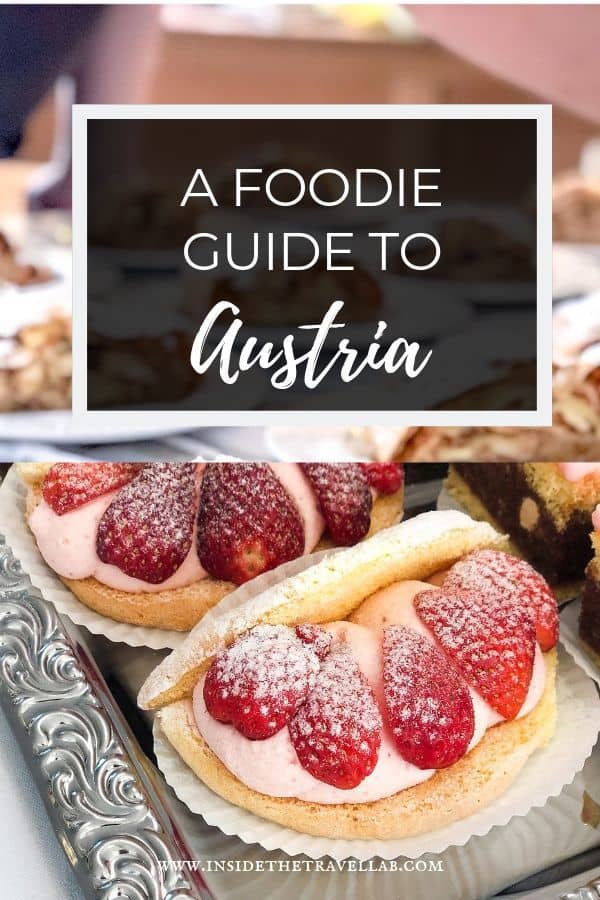
Traditional Austrian Food: The Classics
The best Austrian foods are an absolute delight. But there’s so much more to it than just comfort food like schnitzel and puff pastry. Let’s start there and then take you on a culinary journey that will make you want to book a ticket to Austria right now.
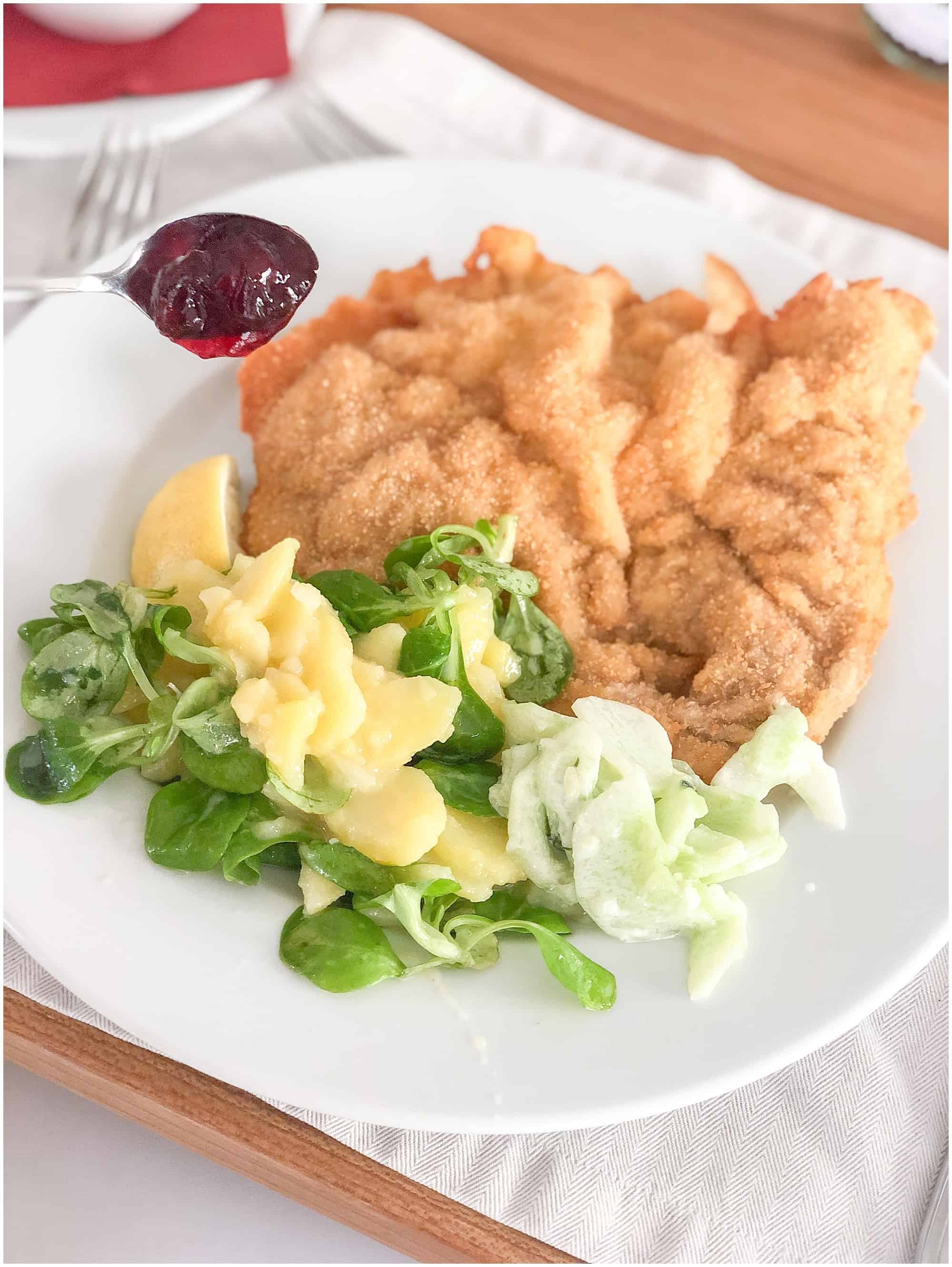
Wiener Schnitzel – Too Famous to Need a Translation
Wiener Schnitzel shnitzes the schnitz out of all the competition. It is the most famous traditional dish from Austria, earning itself a place in the Lonely Planet Ultimate Eat List, as well as on the plates of diners in Vienna and beyond.
But what is the Wiener Schnitzel? Simply put, it’s veal in breadcrumbs but there is a little more to it than that.
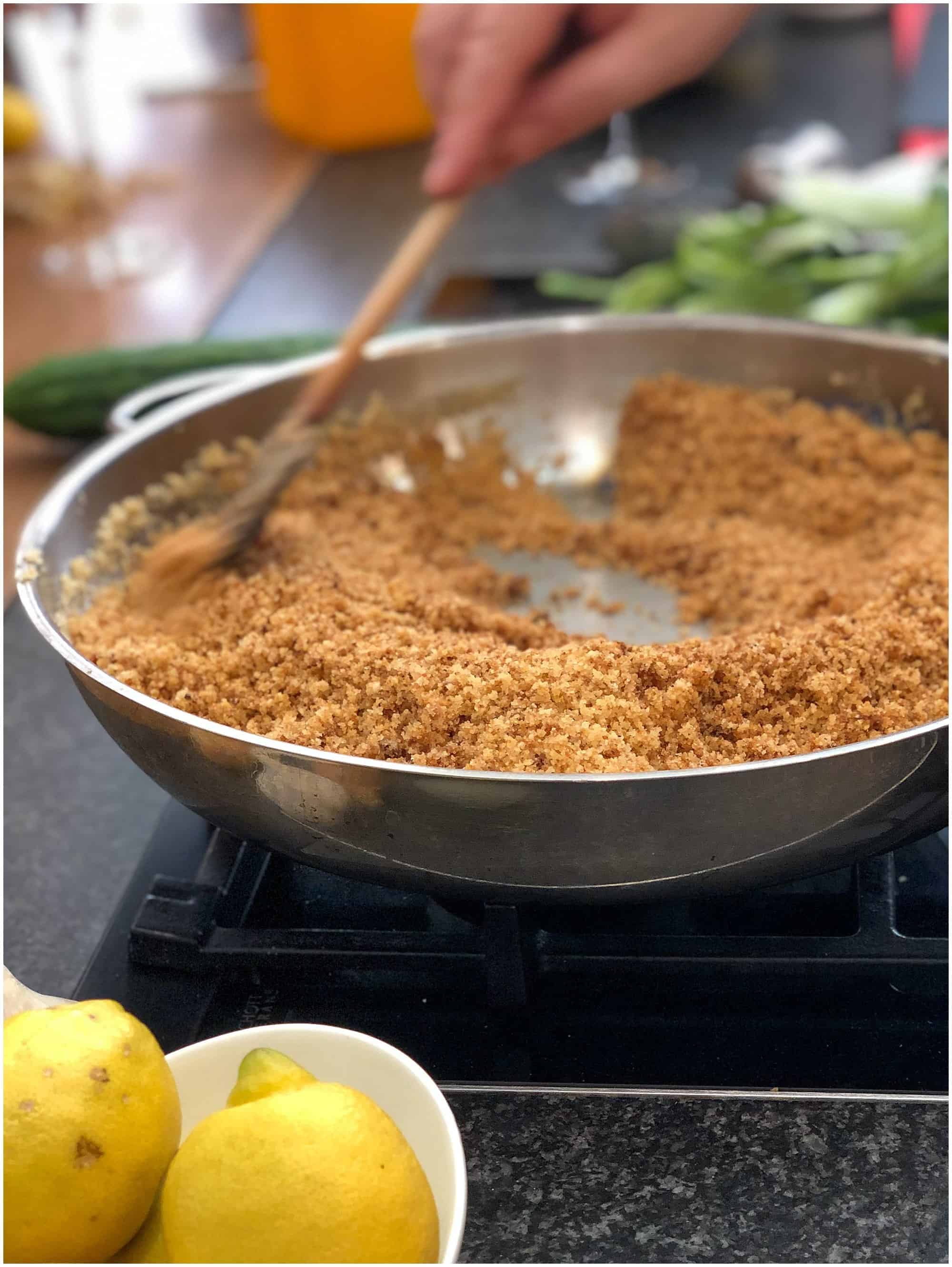
How to Make Schnitzel
The veal is tenderised first, a process with a soft, romantic name but a vivid and brutal reality. While one person is beating the living daylights out of the meat, another is whisking together some eggs and adding a little salt.
The cutlets are dipped in flour then into egg and finally coated in breadcrumbs.
“In Sunday, the sound in Austria is not of music but of thumping. All around the city, people are pounding the table and preparing the schnitzel.”
Nabiel, chef at Andante Cooking Class of Viennese Cuisine.
Then it’s time for the deep fry until golden brown on both sides. The secret involves tossing the pan regularly so that the schnitzels are surrounded by oil and the crumbs become fluffy.
The Story of the Schnitzel
Traditionally, the schnitzel comes with slices of lemon and either a lettuce garnish or Austrian potato salad as a side dish. More recently, you’ll find it comes with french fries. And it’s not just for tourists. This is a typical Austrian food.
Although, that said, apparently the idea originally came from northern Italy, around Milan. The golden breadcrumbs were said to remind people of real gold and so they became a symbol of wealth, and a must-eat in the Royal Court in Vienna.
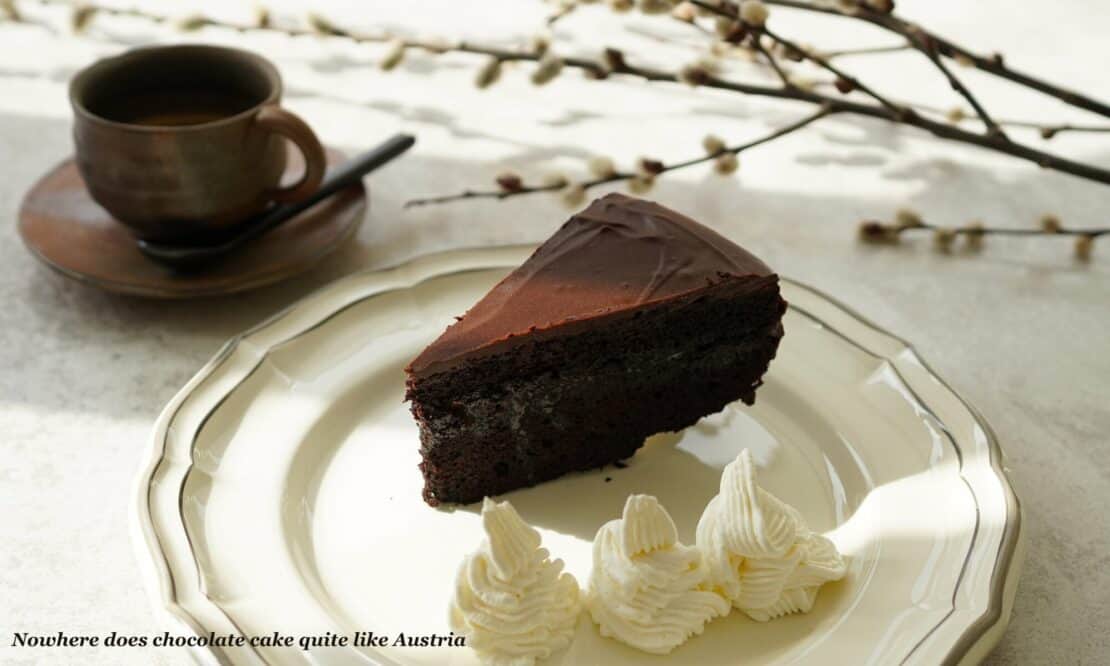
Sachertorte – Chocolate Cake with a Fairy Tale Attached
Up next for reasons of fame, rather any sense of food pairing, is the much-loved Sachertorte. It’s a rich, thick, dense chocolate cake crammed with chocolatiness all around, with thin layers of apricot jam inside. Traditionally, it comes served with unsweetened whipped cream and often has a kind of dark chocolate medallion on top.
In 1832, Prince Wenzel von Metternich tasked his chef with concocting an impressive dish to wow his guests. The chef fell ill but sixteen year old apprentice Franz Sacher came up with the dish and a culinary legend was born.
Like all good legends, it took a while for fame and fortunate to set in. At the time of its invention, Sacher was only in the second year of his apprenticeship. Years later, back in Vienna, he opened a specialty delicatessen and wine shop and started teaching his tricks to his son.
Eldest son Eduard Sacher studied in Vienna with the Royal and Imperial Pastry Chef at the Demel bakery and chocolatier, perfecting his father’s recipe as he went.
Sachertorte first appeared at the bakery and then at the now iconic Hotel Sacher, founded by Eduard in 1876.
Since then, there have been legal battles between the Demel bakery and Hotel Sacher, on the negative side of things. On the positive, there’s also a day for the cake. The US celebrates Sachertorte day each year on the 5th December.
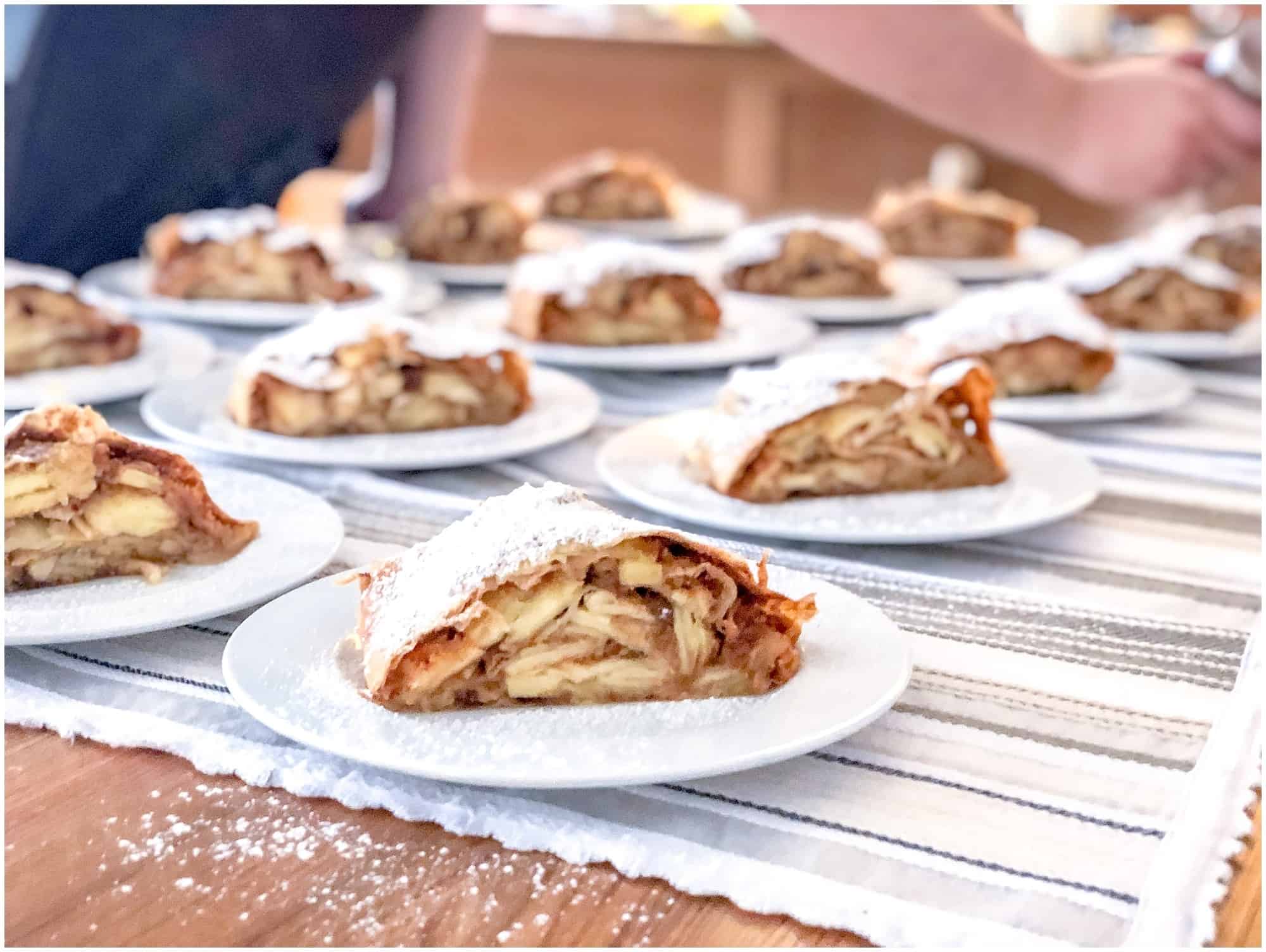
Apfelstrudel – Apple Strudel, Baby
Just the words apple strudel make me think of fresh air, meadow flowers and cosy, fireside recovery after a hike.
As one of the most famous Austrian desserts, strudel strides onto the stage in the shape of the spiral that gives it its name (strudel translates to spiral.)
It’s a dessert made of different parts. The apples are peeled, freshened d with lemon juice, spiced up with cinnamon and then head off to the party with some rum soaked raisins.
The dough requires kneading and stretching until it’s paper thin. This is not something to try on your own the first time around: enlist helpers and, better yet, an expert.
Then there are the breadcrumbs. Ah, the sweetly caramelised in lashing of butter breadcrumbs.
The topping is added to the fully flat sheet and then both ends are held up and the dough is rolled into a spiral to form a giant log.
Chop and bake in the oven. Then dust with powdered sugar and serve with ice cream or vanilla sauce.
Less Well Known Traditional Austrian Food
And now onto the dishes that you may not know – but should.
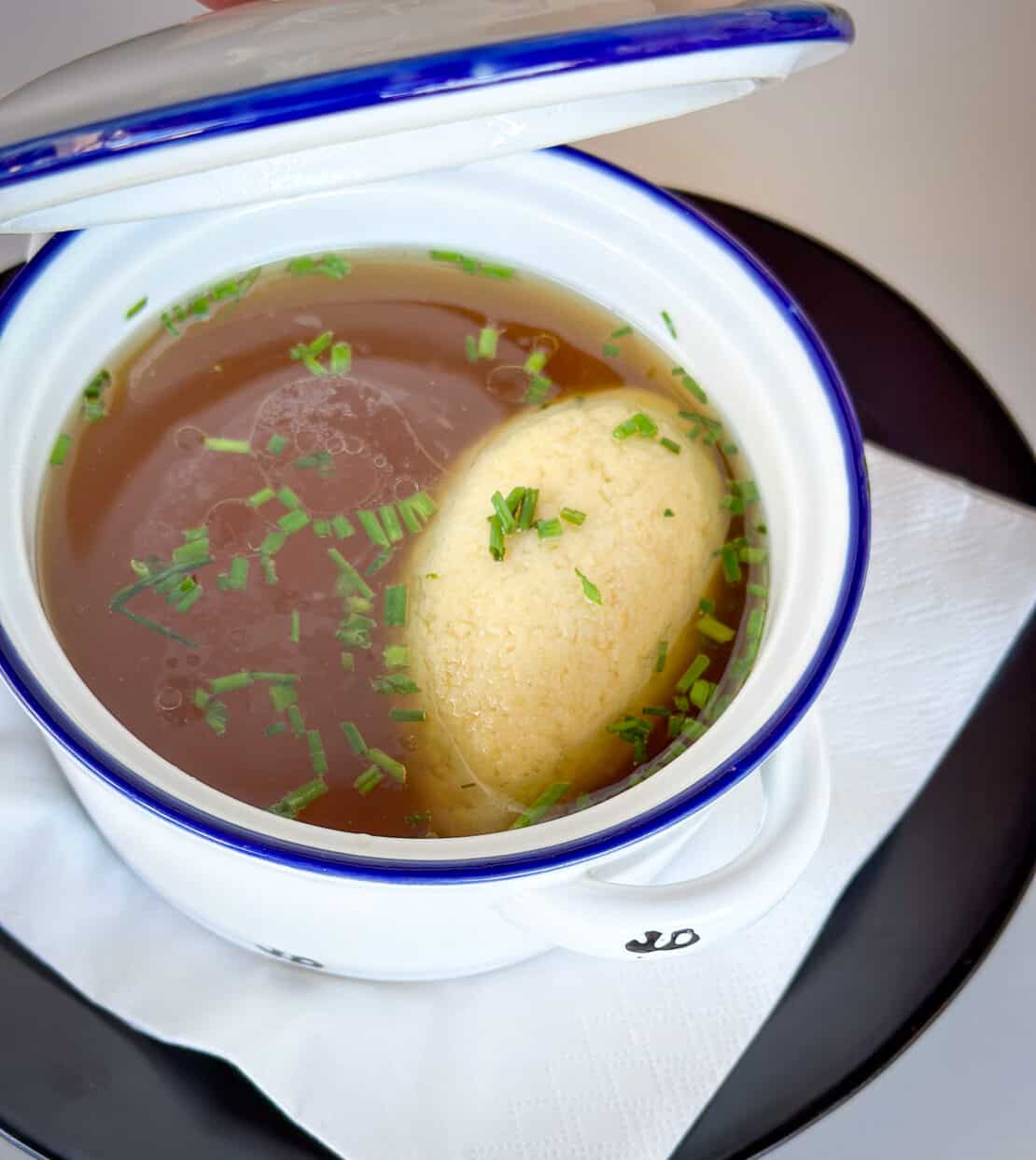
Grießnockerlsuppe – Soup with Semolina Dumplings
This soup may look on the watery side but it packs in its flavour. The semolina dumplings add some bite and a sense of substance, not to mention a challenge in table manners as you try to chase them around the bowl with a hint of finesse.
Grießnockerlsuppe is considered both a traditional Austrian dish popular in Vienna and also one belonging to Bavarian in southern Germany. As always, with these things, it’s important not to lose the sense of bon vivant by getting lost in a squabble of origins.
To make the dumplings, froth butter with eggs and semolina with a dash of salt and nutmeg. Leave the dumplings to rest before cooking in boiling, salted water. Then plop them into the beef soup and decorate with chopped chives. You can also find imitation dishes with bread dumplings as well.
- Recommended Reading: Graz Restaurants to Fall in Love With, Austria
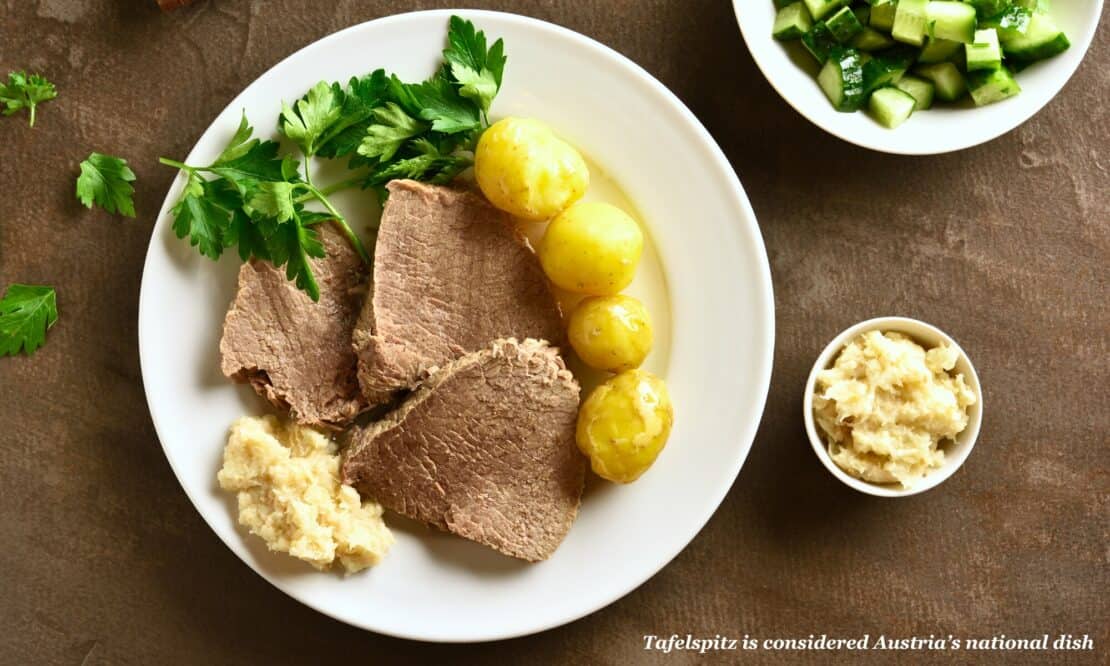
Tafelspitz – the King of the Beef Dishes
Another dish popular in Viennese cuisine is Tafelspitz. The description of boiled veal or beef may not sound particularly enticing but it’s the cut of the meat and the judicious simmering with root vegetables and spices that begins to make all the difference. The side serving of mixed apple, sour cream and chives and a tasteful splodge of horseradish really brings the dish to life.
In popular culture, it’s known as the national dish of Austria.
The Tafelspitz is the Topside, Rump Cap or Top Round, depending on which version of English you use. True Tafelspitz uses meat from a young ox with firm white fat (not yellow)
Slightly questionable historic sources claim that it was a favourite dish of Emperor Franz Josef I, with his approval quoted in a 1912 book of traditional Austrian food distributed across the Austro-Hungarian Empire.
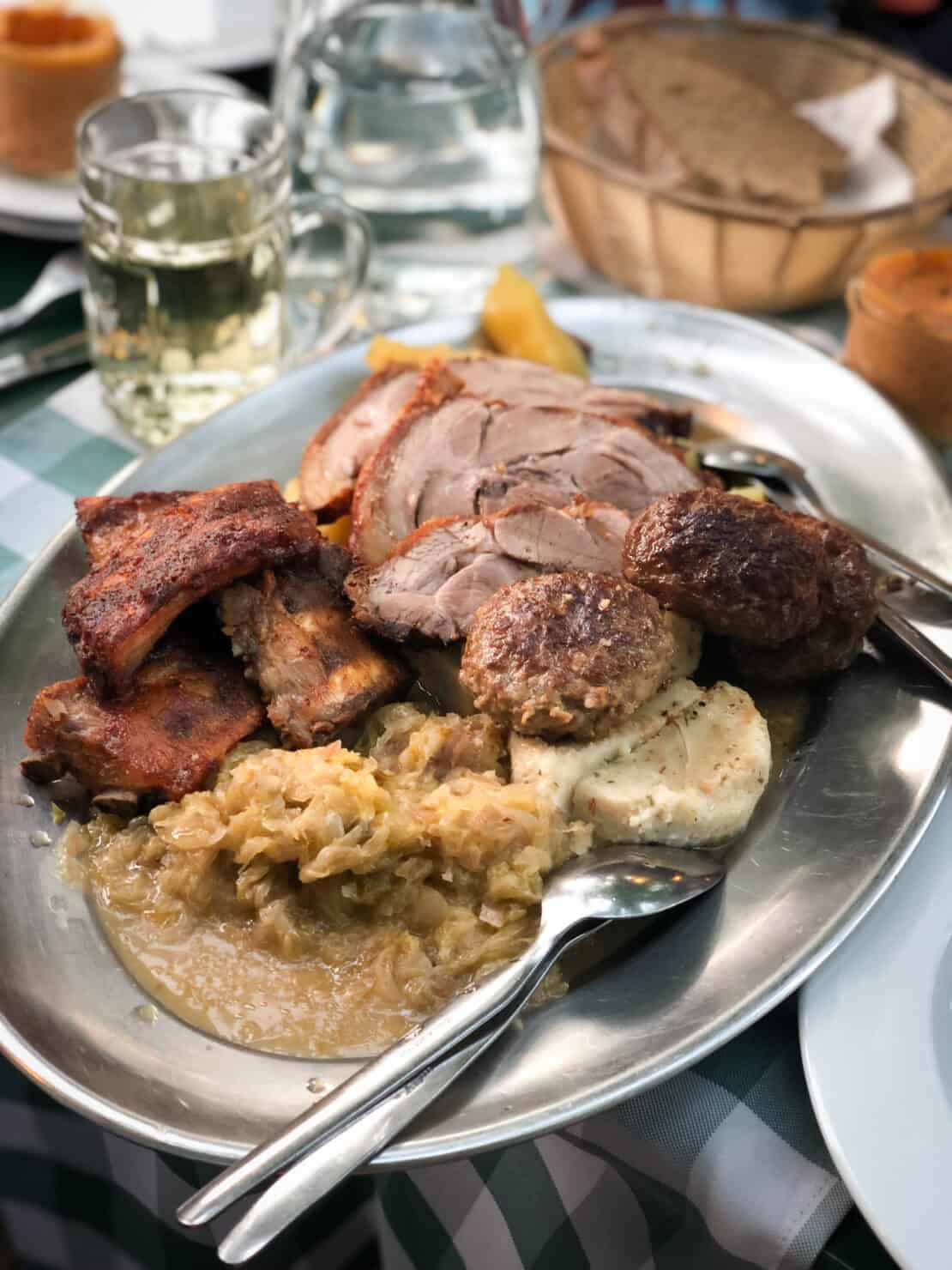
Zwiebelrostbraten – A Traditional Sunday Lunch
With origins shared between Vienna and Swabian Germany, Zwiebelrostbraten involves roast beef and roast onions, served with gravy and either boiled potatoes or (particularly in Swabia) spaetzle.
But the beef receives a good going over before it heads into the oven. It’s seasoned with salt and pepper, sometimes rubbed with mustard or garlic. Its edges are trimmed, surfaces pressed into flour and sautéed in butter with or without the onions. The onions sometimes receive a dashing of paprika and can emerge soft in the sauce or crispy on the top, depending on how and when the addition of stock, broth or wine came about.
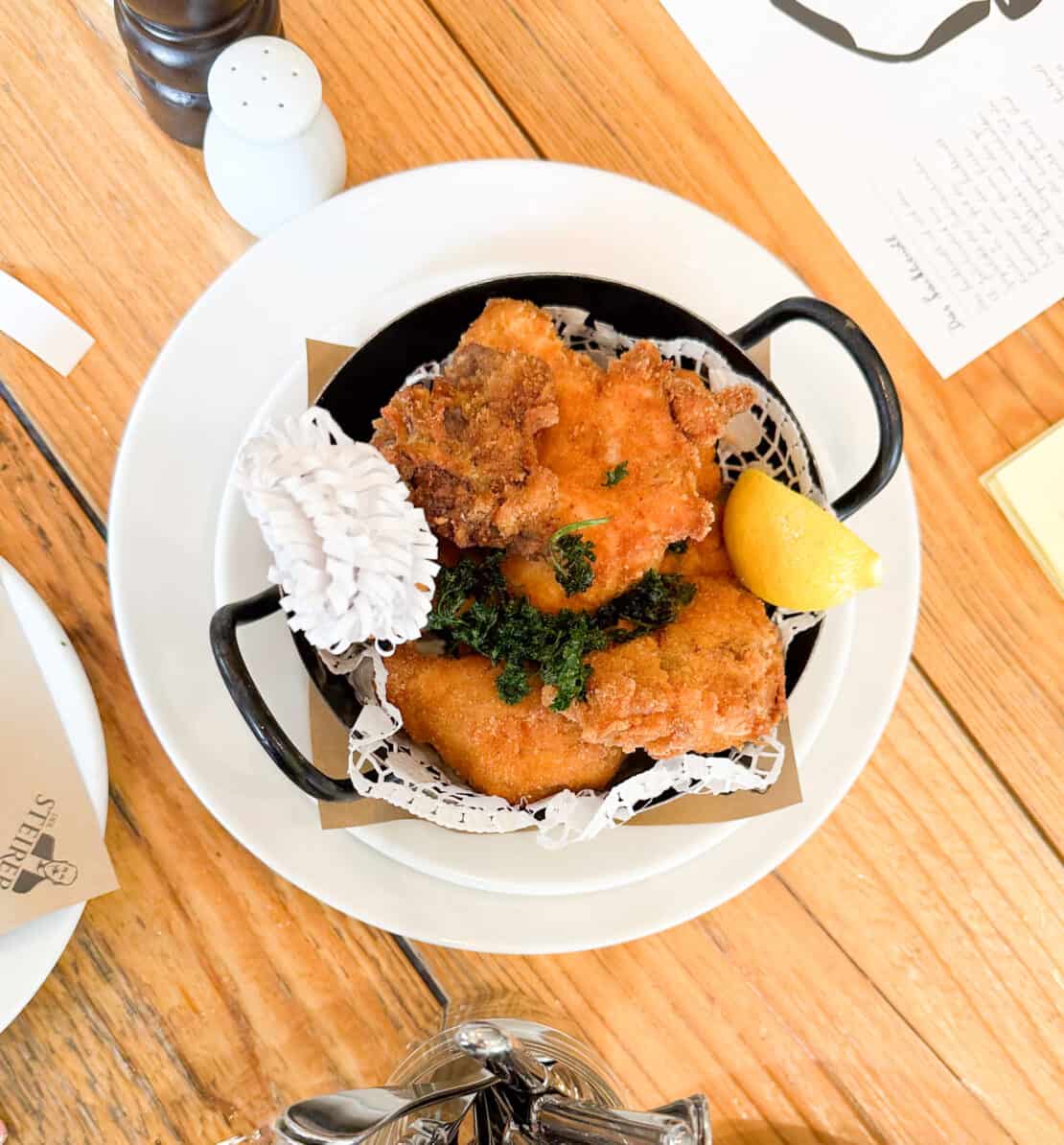
Wiener Backhendl
Another typical Austrian dish from Vienna is the Wiener Backhendl, often just shortened to Backhendl. This simple dish involves chicken thighs in breadcrumbs, but it’s deep, deep fried and lightly spiced. Again, it comes with a slice of lemon and lettuce garnish.
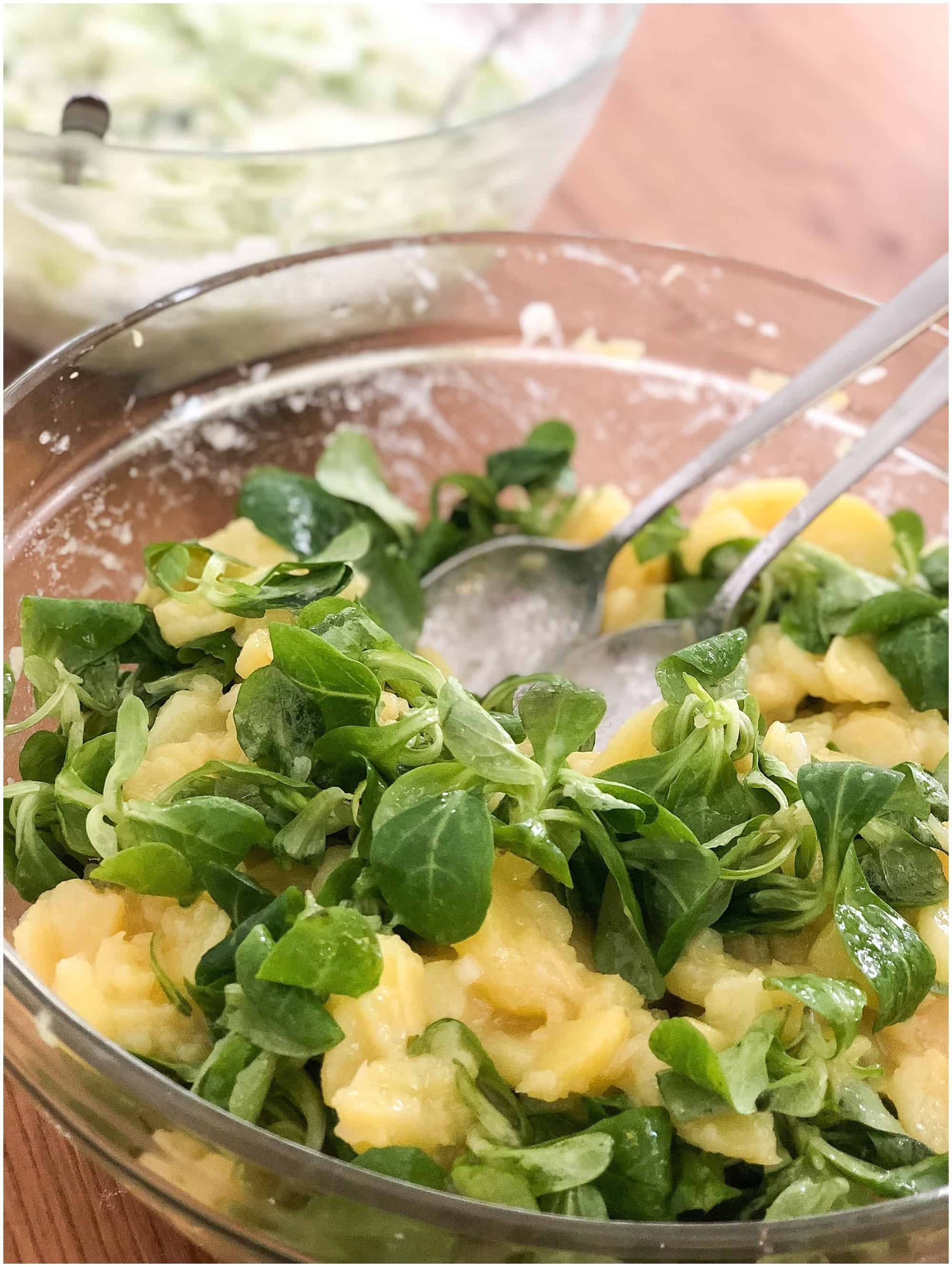
Austrian Potato Salad
I love a good old Austrian potato salad. It tastes both lighter and sharper than the ones we have at barbecues at home, even though it doesn’t “count” as a main course.
Waxy new potatoes are peeled and boiled and then served with sliced red onion, oil and apple cider vinegar. Some recipes add a dash of sugar to sweeten the bite but the real secret ingredient is the traditional Austrian Estragon mustard.
Once again, serve with lettuce!
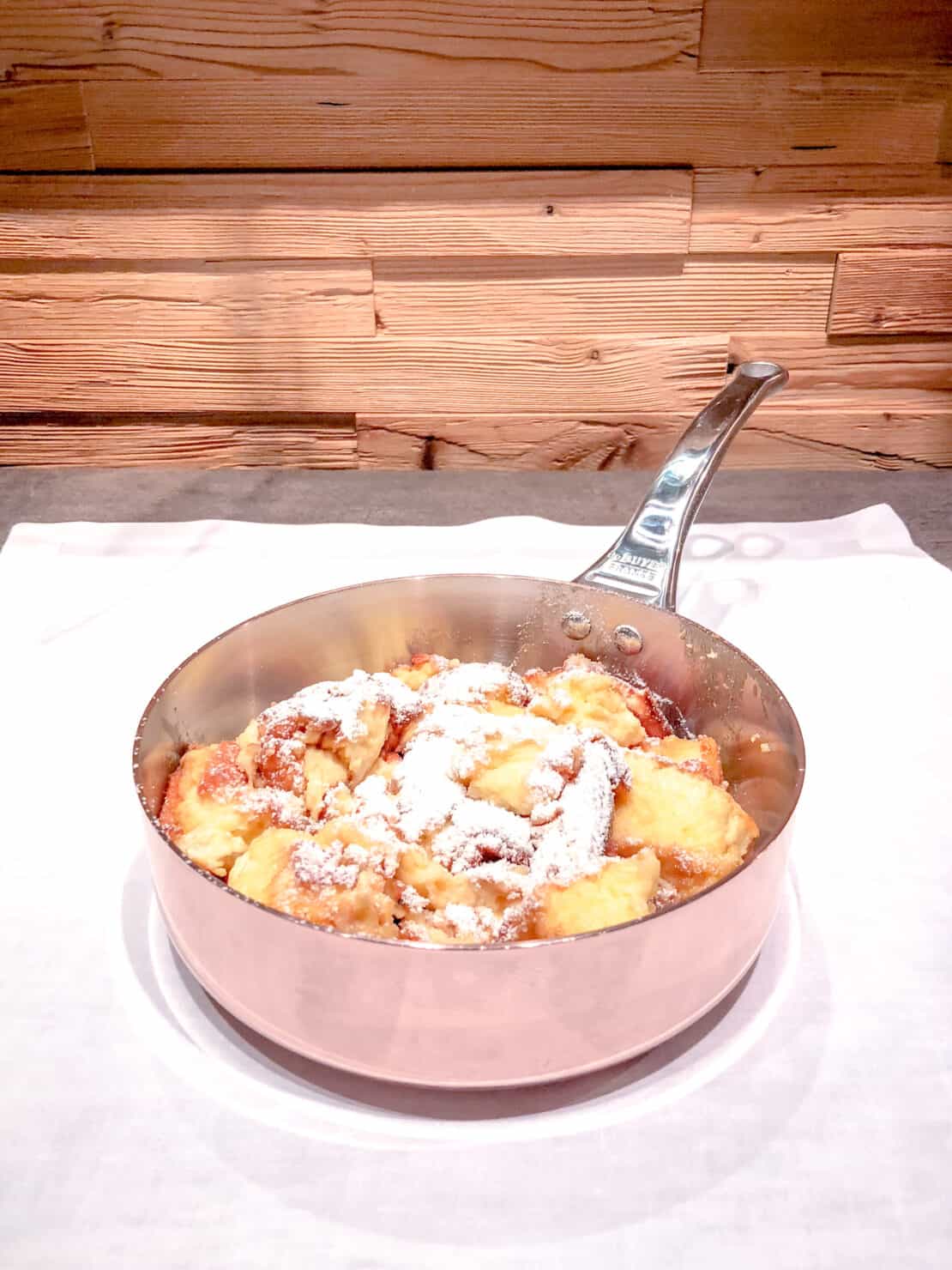
Kaiserschmarrn – The Emperor’s Mess
Often described as Kaiserschmarren, this classic Austrian dish is the foodie equivalent of a pillow fight in a pancake factory, all to the confetti storm of sugar.
Schmarren means to shred or scramble, mess or mishmash. Kaiser is, well, the king.
The pancake itself is lightly battered, thick, fluffy and slightly caramelised. It’s torn into pieces with a fork while frying in a process with as many legends behind its origin as there are ways to finish the dish.
My favourite is simply that the Emperor was travelling around the country and stopped to dine at a farm. The cook was too nervous to contemplate a traditional pancake and so fluffed the whole thing up along the way to make it look deliberate. Kind of what I would do in a similar situation.
Today, Kaiserschmarrn comes with nuts, cherries, apple sauce or plum jam, although originally it came with raisins soaked in rum.
On the side, you’ll find all kinds of sauces or jams but the traditional flourish involves Zwetschgenröster: a plum fruit compote.
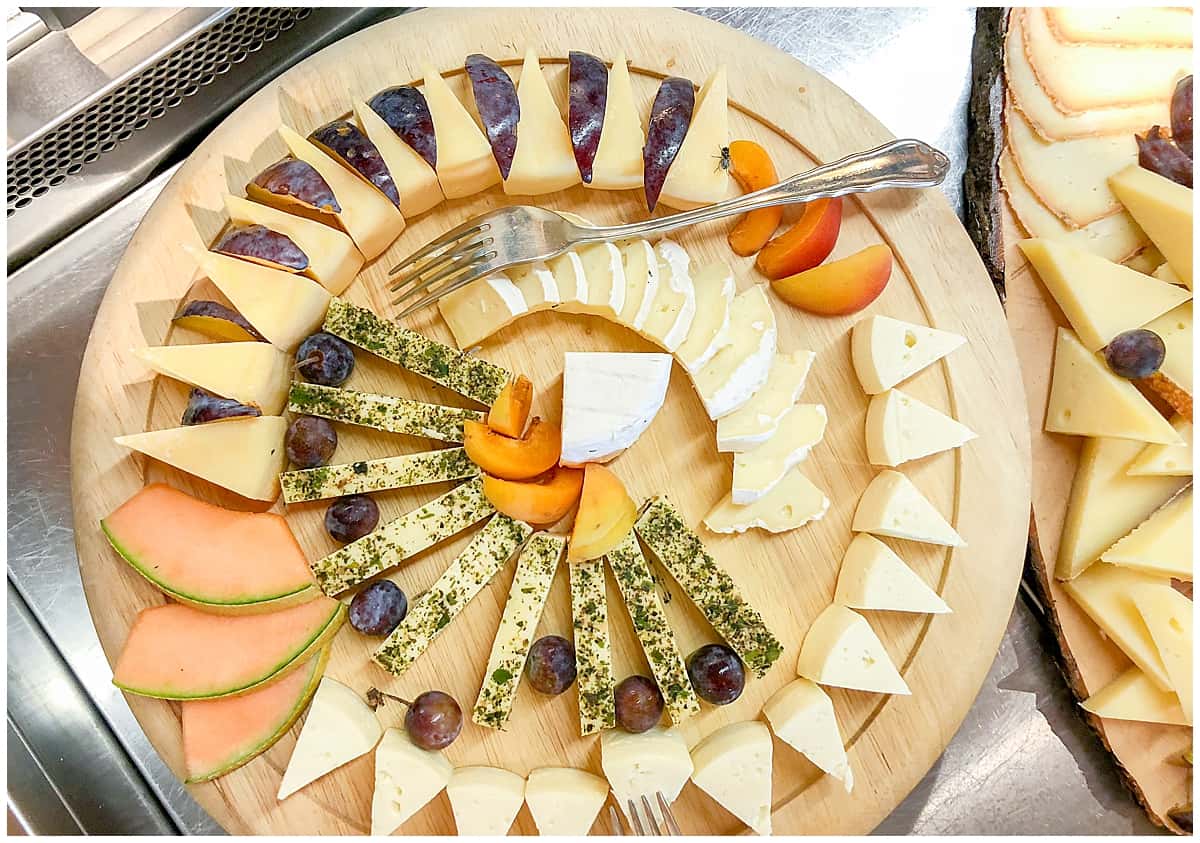
UNESCO Approved Cheese
Far from Vienna but still on the Austrian dining scene is the Käsestrasse or cheese road. For over 100km, it winds its way through the mountains of Bregenzerwald, taking in the obligatory picturesque wooden chalets and mixing in some innovation.
UNESCO have recognised the Käsestrasse as a on account of its centuries old production techniques and approach to sustainability.
Hiking the Austrian alps by day and munching on hard cheese by night is a justly celebrated pastime in this part of the world.
You can read more about the Käsestrasse or cheese road in Austria here.

The Linzertorte – Latticed Pastry Loveliness
Arguably, the oldest cake in the world, the Linzer torte hails from the city of Linz rather than capital Vienna, and takes a twist to the standard torte design. The Linz version is single layer, starting with the unsalted cinnamon-spiced base, following along with a plum, redcurrant or raspberry jam and showing off with a lattice pasty finish on the top.
When apricots are in season, you can find it made with those as well.
Typically eaten around Christmas time, look out for Linzer sables in local restaurants and bakeries: smaller, cookie sized version of the traditional Austrian dessert.
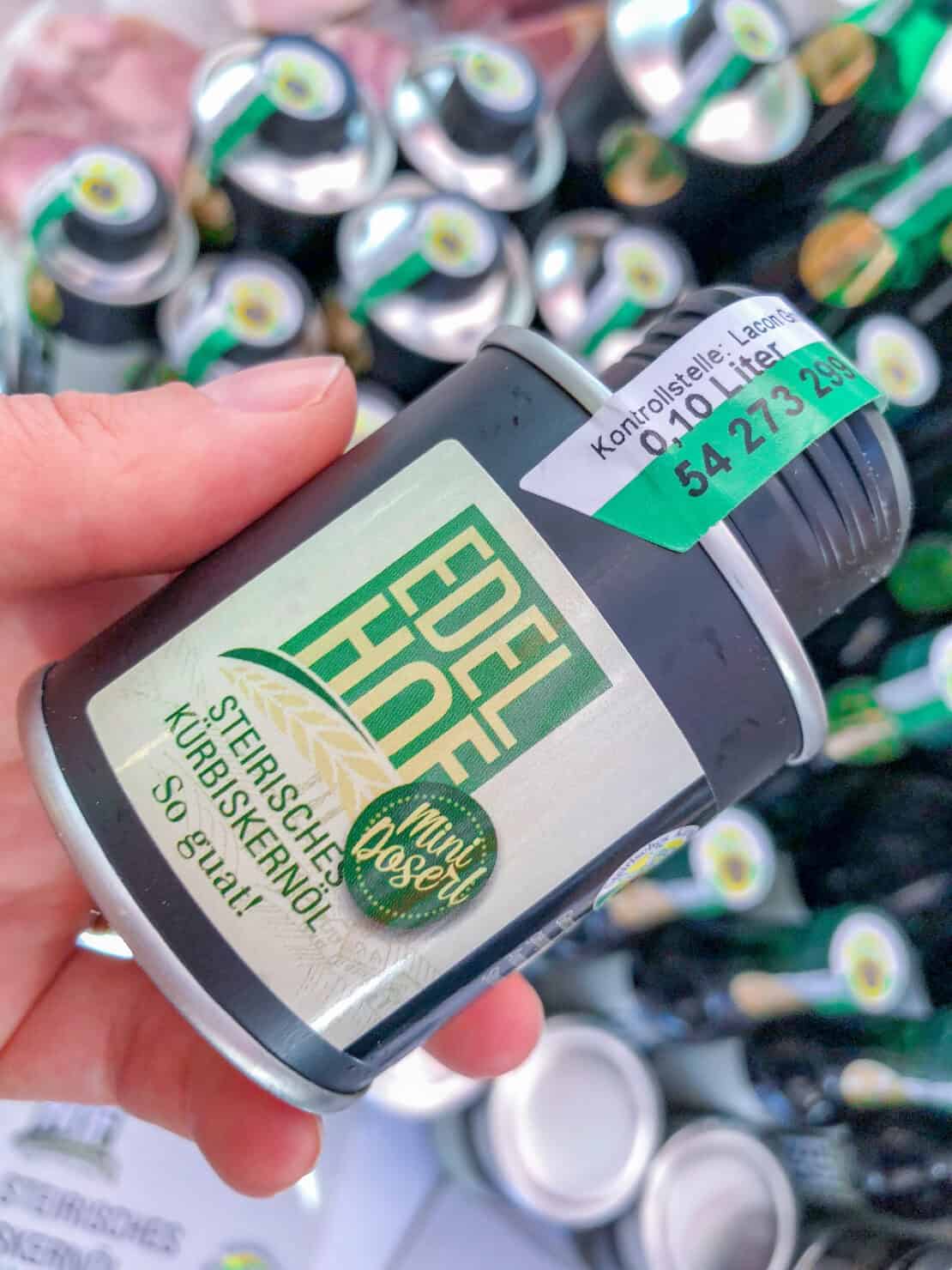
Pumpkin Oil
Green and bright, nutty and tasty, pumpkin oil is a big deal across Styria and easily found in both kitchens and markets in Graz. It’s delicious drizzled across bean salads, another specialty of the region.
What About Street Food in Vienna?
The Würstelstand, or sausage stand, can be found throughout the Austrian capital. They serve dirty great helpings of sausages, buns and onions. Fun fact: Würstelstands started as portable food stations to help the disabled returning after war. Only in the 1960s did the laws relax to allow them to stop moving and stay still.
Traditional Austrian Foodie Experiences
It’s not just what you eat but how you do it that counts! Austrian dining traditions are fantastic inventions, worthy of a mention in and of themselves. Here are four of my favourites. Ah, go on, make that five!
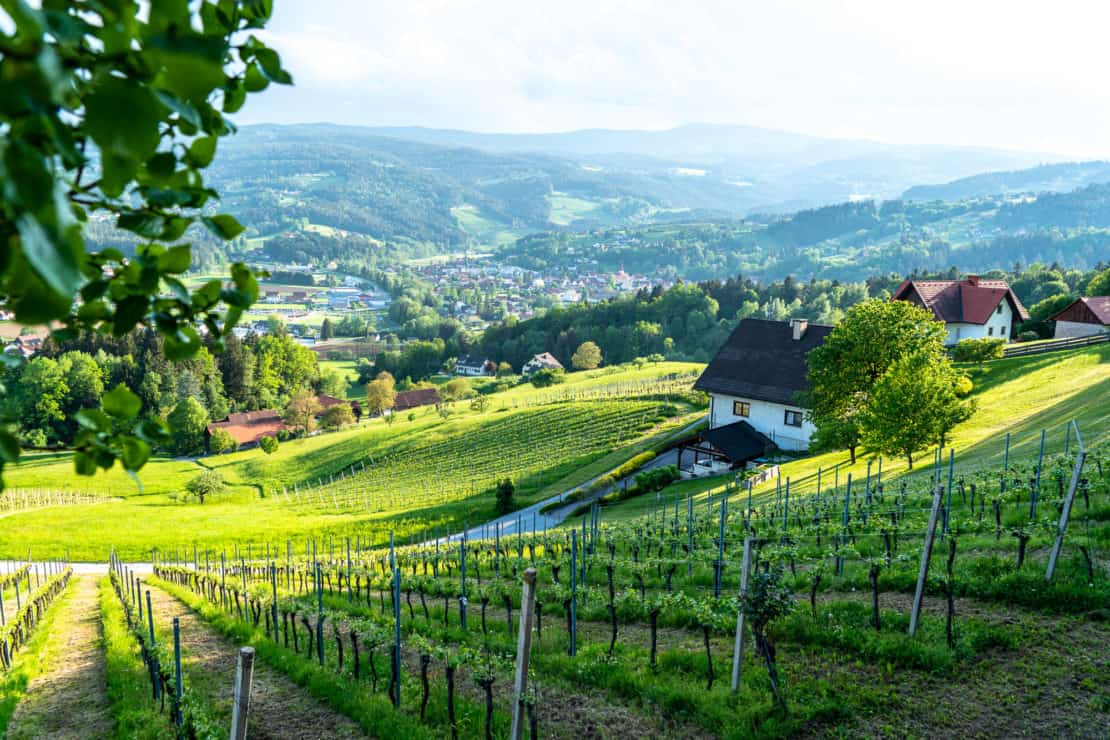
Brettljause in a Buschenschank
Don’t be frightened by the lack of vowels in the words, a Brettljause in a Buschenschank is a lovely Sunday afternoon tradition. Austrians hike or cycle in the mountains before heading to an independent, locally run Buschenschank for a platter of cold meats, locally sourced salads and home-grown red and white wine. Delicious!
It’s one of my favourite things about Austrian food culture.
- Recommended Reading: Buschenschank Steiermark: A Beautiful Austrian Tradition
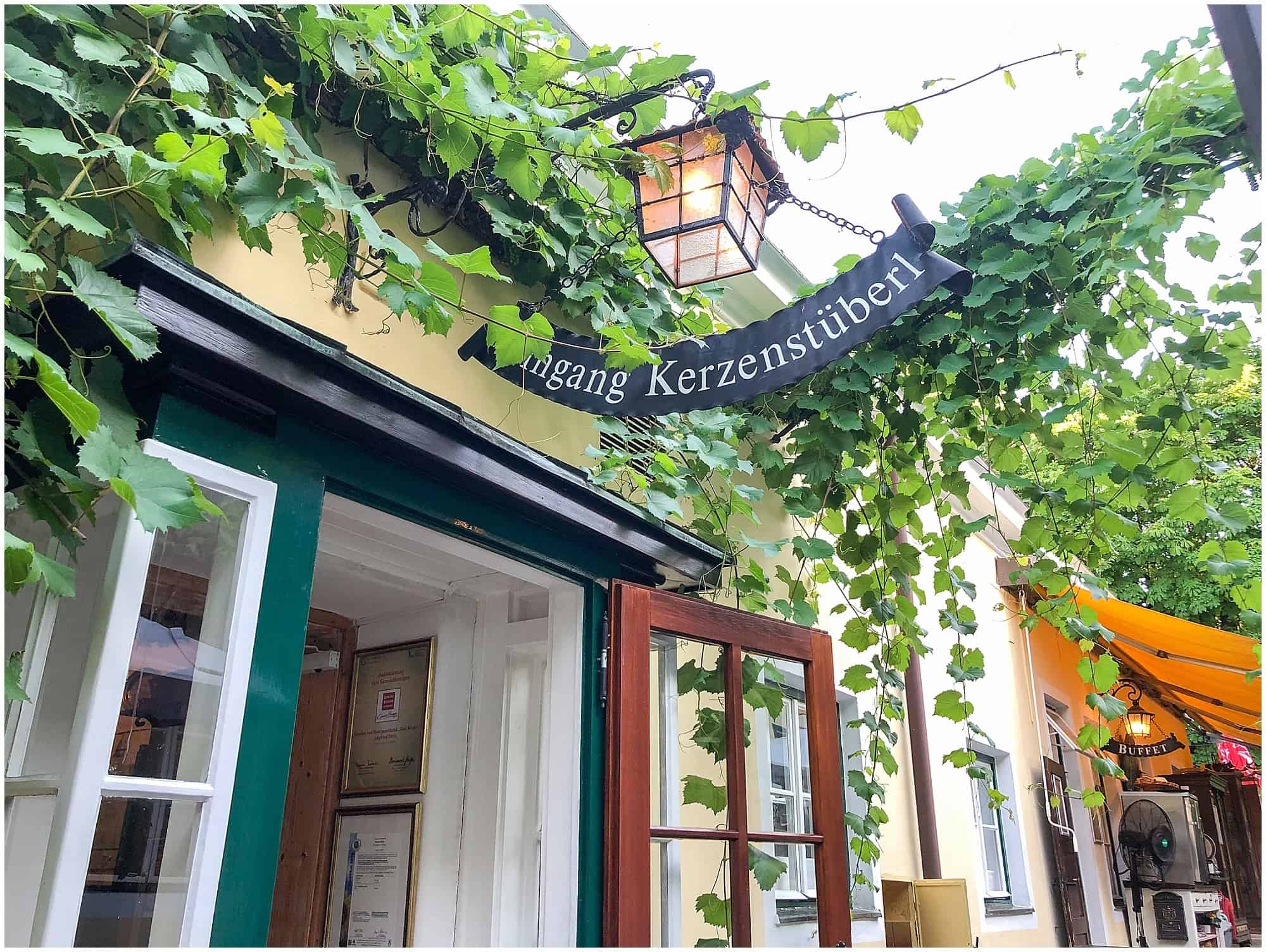
Heuriger – This Year’s Wine
In a similar way, the Heuriger or wine taverns of eastern Austria serve timeless food with locally grown wine following curious tax laws that date back to the days of the Emperor.
Cold meats, sausages and other popular dishes appear with the Veltliner and Gemischter Satz wines, as live music plays traditional jigs and the leaves of the vineyards flutter into the night.
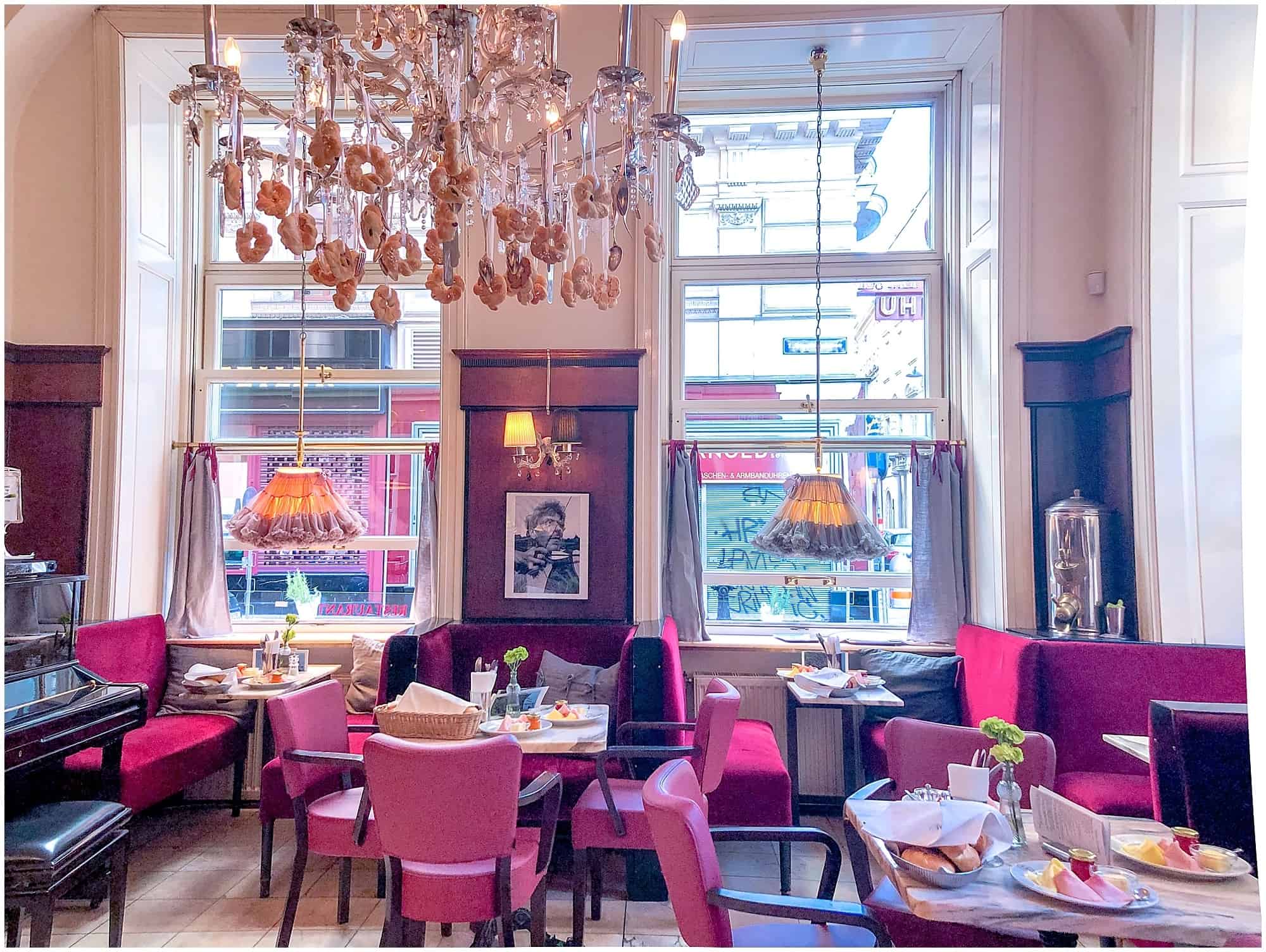
Vienna’s Coffee Houses – UNESCO Chats with Your Friends
Vienna’s coffee house tradition moves beyond just Friends-style lounging and has earned itself a place on the UNESCO intangible world heritage list.
They’re described as places “where time and space are consumed, but only the coffee is found on the bill.” But what’s the big deal?
For a start, you’re encouraged to linger, with a newspaper and Viennese coffee and think or talk for hours. When rents were high and the city crowded, intellectuals and writers of the 19th and 20th centuries made these coffee houses their libraries and think tanks.
Names like Klimt and Trotsky made the coffee house cool and their caramel-coloured décor and walls seem to speak to a simpler time.
Apart from coffee, you can taste a classical Viennese breakfast here. This includes cold meats, sliced cheese and coffee. But what makes it so special is the atmosphere of the Viennese café and the early morning stroll around the secret streets of Vienna.
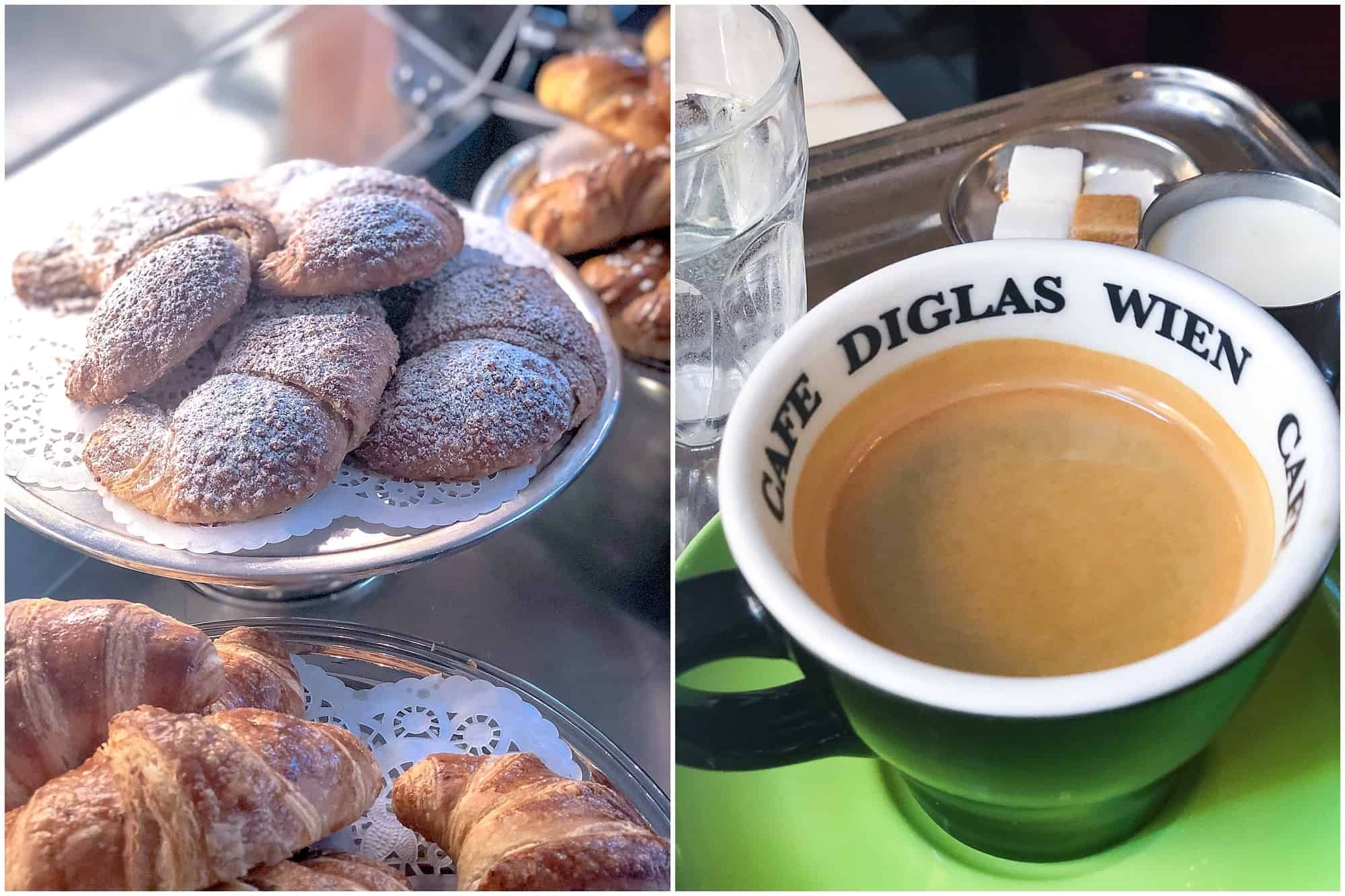
Afternoon Tea in Upper Austria – Kipfel and the Original Croissant
Afternoon tea comes more often with coffee but it always comes with a platter of sweet treats and delights in every colour of the rainbow. Expect rum and spice based Christmas desserts. Light cream and strawberry pastries.
And my favourite? The one claimed to be the forerunner of the croissant. During the Turkish invasion, the half-moon pastry became popular in Vienna. When Marie Antoinette, daughter of the Habsburg royals, was married off to Paris, she took the pastry with her.
According to those in Upper Austria, the croissant is a traditional Austrian dish. From Asia to Central Europe to Paris.
Traditional Austrian Drinks
It would be remiss to talk about typical Austrian cuisine, without pausing for a moment to talk about the drink!
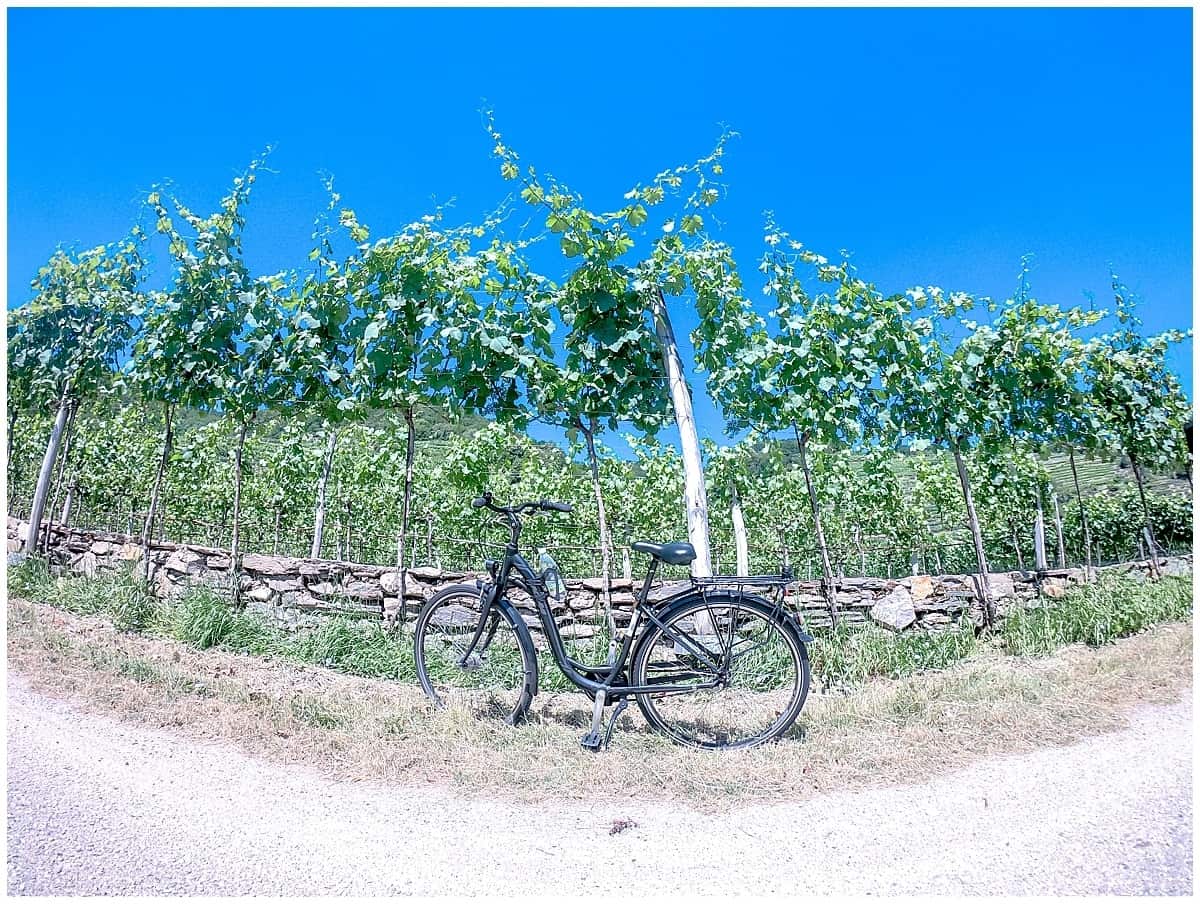
Wine – the Highest Vineyards in Europe
Grüner Veltliner are the most commonly grown grapes in Austria, with vineyards clustering just outside Vienna and along the Wachau Valley.
Another lovely thing to do is to travel to Styria, around Graz, and explore Europe’s highest vineyards.
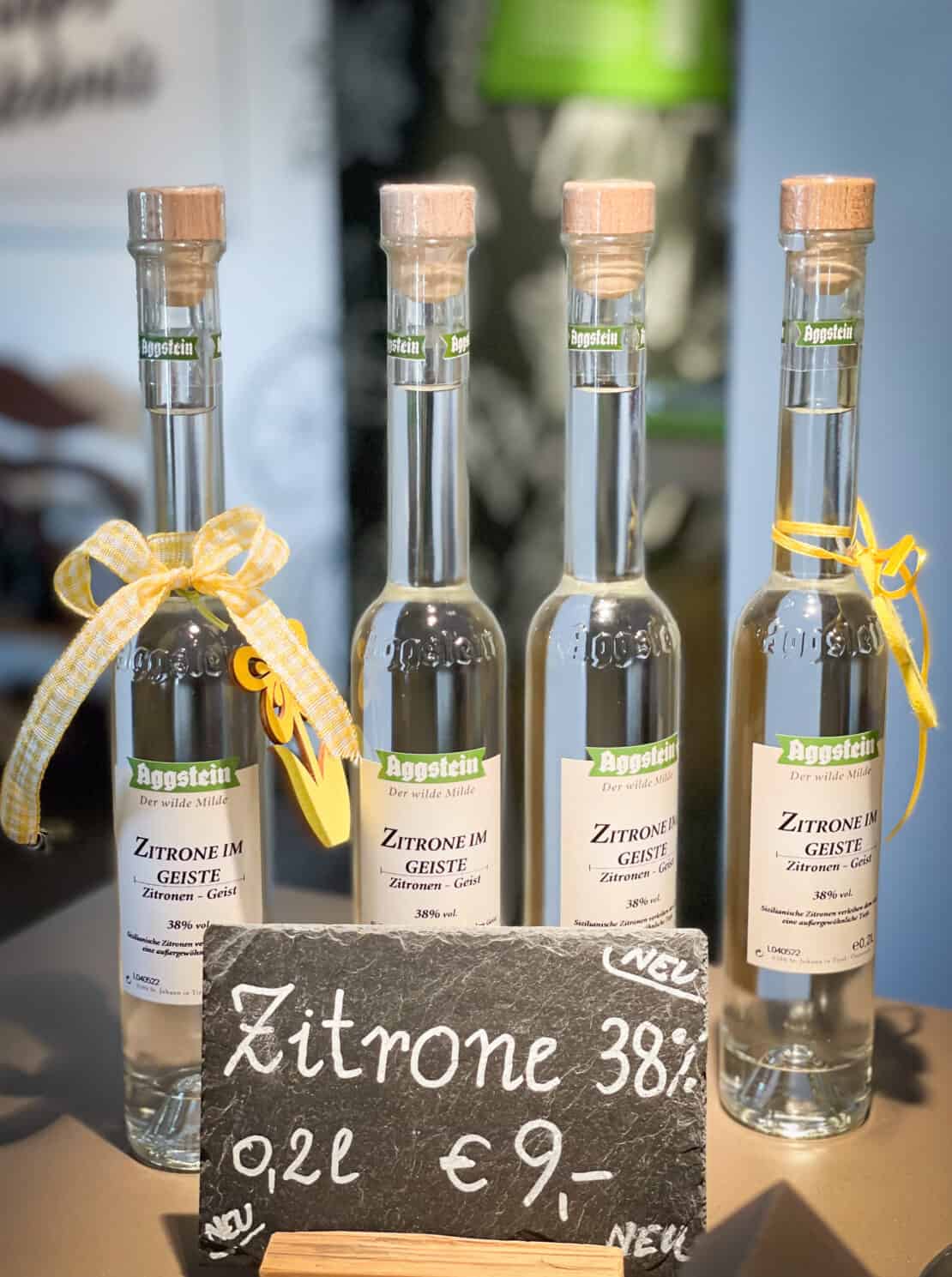
Schnapps – Once Tried, Never Forgotten
Schnapps can be found across Austria, from isolated mountain huts to well-stocked cruise ship bars. The term covers a range of sins, including herbal liqueurs, distilled fruit brandies and neutral spirits with a splash of fruity syrup. They come in shot glasses and are expected to be swallowed fast.
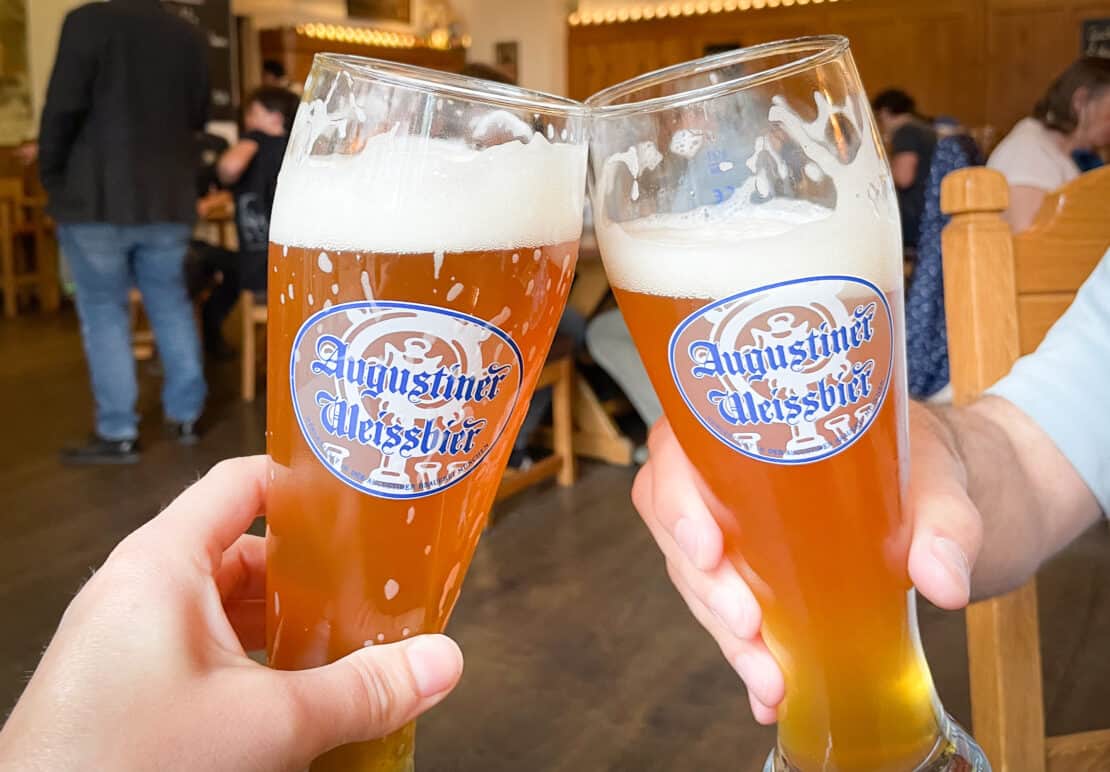
Beer – Second Only to the Czechs
Legend says that Austrians consume 106 litres of beer per person per year, a figure only exceeded by the Czechs. In Vienna, look out for local lad turned good Ottakringer in the 16th district. It’s been pulling pints since 1837. Stiegl, Zipfer and Gösser are the other big brands, with microbreweries popping up across the country too.
And they’re not all new. The Engelszell Abbey in Engelhartszell is a Trappist monastery founded in the 13th century with only four surviving monks. It also happens to sell its own craft beer and run beer tastings: from the aromatic chocolate Gregoria to the amber Bento Trappistenbier.
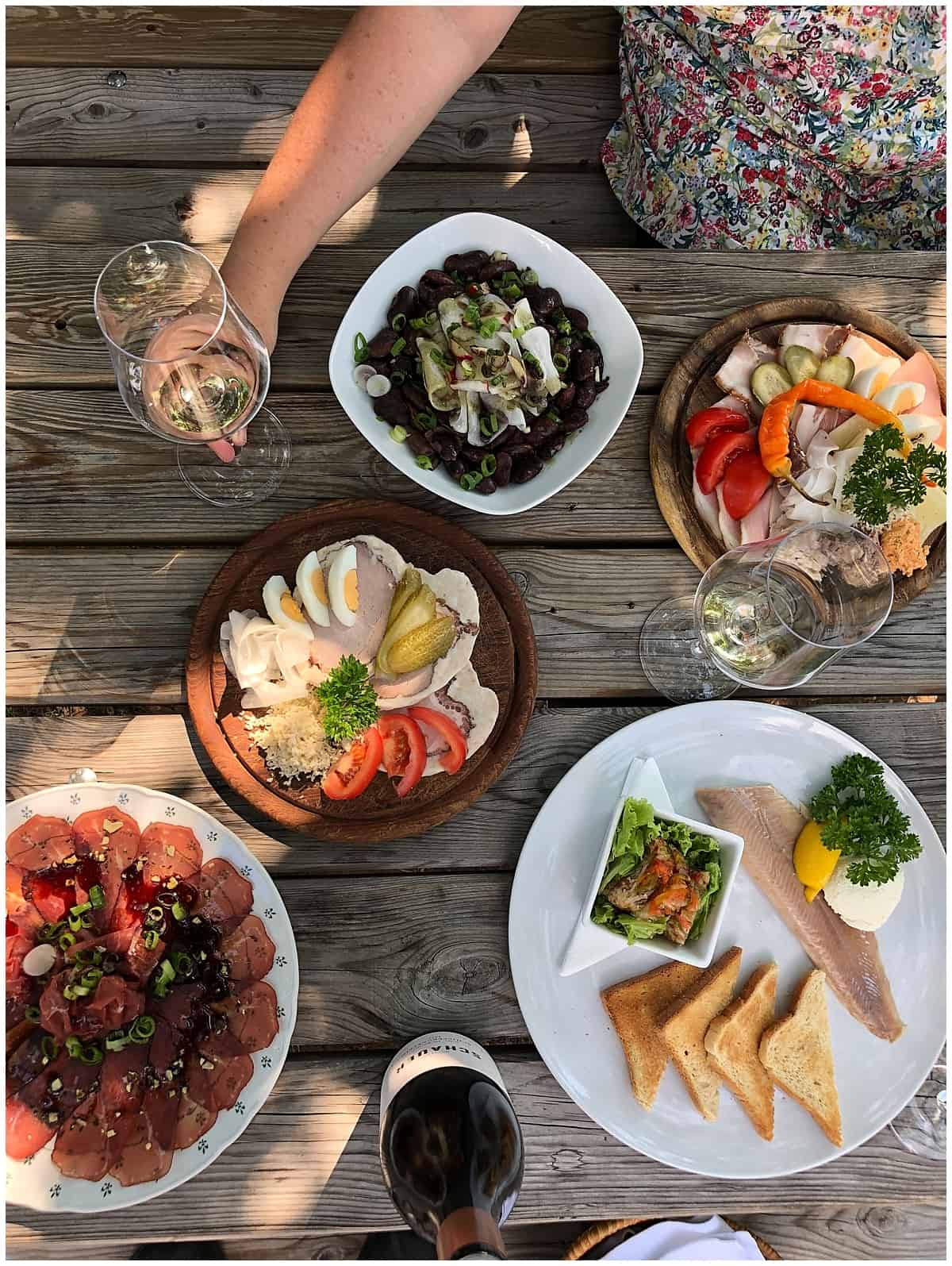
Avalon and Learning About Austrian Cuisine
Absolutely the last place in the world I expected to learn about traditional food was on a cruise. Cruises were all about mass produced burgers and ignoring local culture altogether, weren’t they?
Not so with Avalon.
Their Active and Discovery cruises have more excursions than are possible to take. Every single day. They work with local tour guides and chefs and take passengers out in small groups (ranging from one, yes, one to 60) on a wide range of different options.
Meanwhile, the three meals a day, plus afternoon tea and mid-morning snack, are updated daily to match the local culture of the port in question. Meals are included as part of the cruise, with a la carte and buffet options, which means you can try a HUGE range of different traditional dishes. Ingredients are locally sourced, for the most part, and all staff on board are EU citizens.
Finally, if you’re really hankering for it, it turns out there are hamburgers available on demand.
Avalon Foodie Excursions
Off the ship, on their Budapest to Linz route, you could try:
- Cooking lessons in Vienna
- Dinner in a traditional Heuriger
- Early morning breakfast in a Viennese cafe
- Beer tasting with Trappist monks
- Pub crawl in Vienna
- Wine tasting in the Wachau valley
And that was just in Austria. Even more traditional food experiences were available in Hungary.
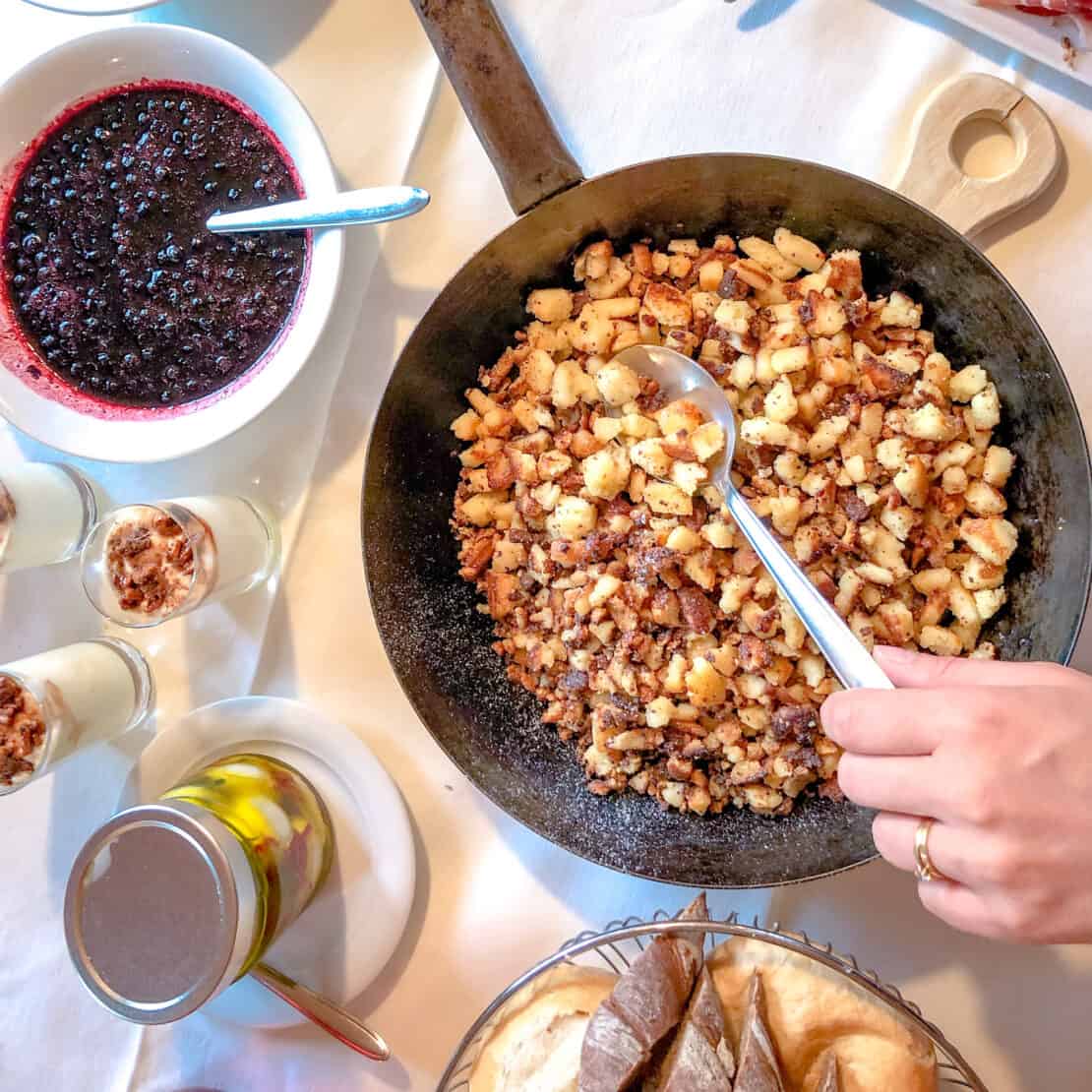
Closing Thoughts on Austrian Cuisine
Of course, we’ve only scratched the surface here with this introductory guide to traditional Austrian food. There are regional specialties, like pumpkin oil in Styria, just waiting to be explored. Browse around through the rest of our articles on Austria to find more about tasty Austrian cuisine.
Disclosure – I travelled with Avalon Waterways as part of a paid project with iAmbassador. I kept the right to write what I like. And eat what I like too :-) If you book or buy through links on this page, we may receive a small commission at no cost to you. Cheers!
More on Travel in Austria
- Why summer in Austria is good for you
- Unique things to do in Graz, Austria’s city of design
- The 10 traditional Austrian dishes everyone should try at least once
- How to enjoy summer in Lech in Austria
- The secrets of the Cheese Road in Austria
- The best places to eat in Graz, Austria’s culinary capital
- Buschenschank Steirmark. Tricky words, great concept
- Dark tourism in Vienna: is it ethical?
- 15 Beautiful lakes in Austria
- Why St Johann in Tirol is Your Secret Tonic this Summer
- The best things to do in Innsbruck (plus an itinerary)
- What the Viking Aegir Danube Waltz Cruise is really like





